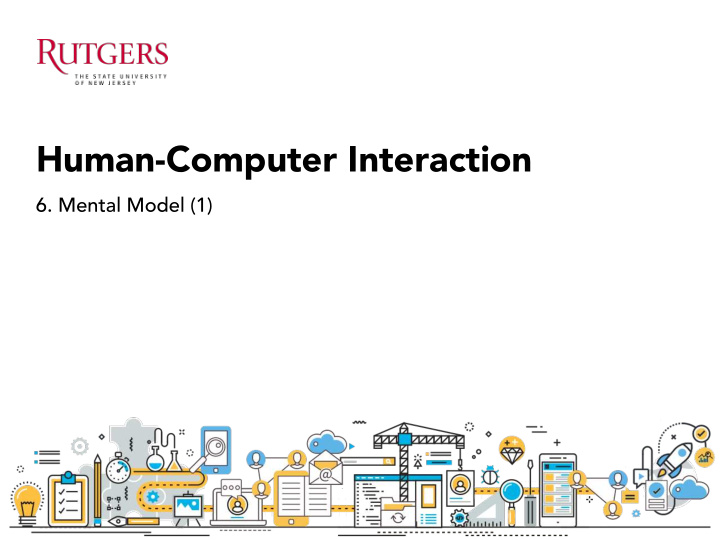



Human-Computer Interaction 6. Mental Model (1)
Recap: Interview: Ask More! Ask “Why?” and “How?” until you get an interesting answer or • subject gets frustrated. “Tell me more!”: Ask for more details on anything that sounds • interesting Repeat/rephrase/summarize to make sure you understood • Follow-up questions Ask why • Ask for an example • Clarify terms • Ask for step-by-step actions • Make the interview to be about them, not you •
Recap: Survey Types of survey questions Mutually exclusive choices • (radio buttons) Non-mutually exclusive • choice (checkboxes) Ranges (overlapping, open- • ended) Likert Scale • Short answer fill-ins • Comments •
Recap: Likert Scale Best used to measure and evaluate customer sentiment on a specific • product, service or experience Response labeling is important! • Common Likert Scale questions: • 1. Agreement 2. Likelihood 3. Satisfaction 4. Importance
Recap: Interview or Survey? Interviews Interviews Surveys Surveys Explore a domain Defined sample from larger population • • Probe & follow-up ➔ Generalizable • Capture multiple data sources Comparatively low cost • • Rapport-building à Can ask Ask multiple questions efficiently • • about sensitive issues Standardized data allows comparisons • Quantitative results • But poor for: But: Starting research • Expensive • Determining questions to ask • Requires coding to interpret data • Clarifying questions for respondent • Difficult to make comparisons • Following up unexpected comments •
Today’s agenda Mental models
Mental models
. I'm fat because my metabolism Obesity is due to eating too is slow, hormone and gland much and not enough problems and too much stress. exercise. The patient is to Health professionals should help blame, so solutions must start me lose weight. I am most with the patient. The biggest worried about difficulties getting concern is diabetes. to work.
Mental model “How your mind thinks that something works”
You form mental models about everything you interact with.
Mental models are abstract representations.
Mental models let you make predictions.
Mental model “The models people have of themselves, others, the environment and the things with which they interact. People form mental models through experience, training and instruction” An explanation of someone's thought process about how something • works in the real world Enable people to reason about a system • Affect the way we see and interpret reality • When users approach an unfamiliar system, they subconsciously refer • to their mental model, User’s model “To break a mental model is harder than splitting the atom.” --Albert Einstein
Let’s make some predictions What will happen to the refrigerator when you turn the left dial up to “colder”? What will happen to the freezer?
One reasonable mental model:
How it actually works: What will happen to the refrigerator when you turn the left dial up to “colder”? What will happen to the freezer?
User’s vs. designer’s model the conceptual model of the the way the system to be user built interprets the System Image
Mismatch between User’s and Designer’s model
Mental model mismatches lead to slow performance, frustration, and errors Two main kinds of errors: Slips - you have correct mental model but mess up in performing the action • (you’re distracted by groceries, so turn the wrong dial) Mistakes - you perform the action you intended (turn what you think is the • right dial), but have wrong mental model
Mental model mismatches lead to slow performance, frustration, and errors How a designer can prevent the two main kinds of errors: Slips - prevent by having better visual/tactile aesthetics, larger hit targets, • more salient spatial layouts [easier] Mistakes - prevent by better conveying the designer’s mental model to the • user [harder]
User’s vs. designer’s model As a designer, you want to use the system’s UI to accurately convey your mental model of the system to the user.
User’s vs. designer’s model It is difficult because the designer is often way too familiar with their own system to empathize with what users don’t know.
User’s vs. designer’s model The system’s UI is all that you have. You can’t directly talk to the user!
Designers of this fridge control must have thought that their mental model was the “obvious” one, which is not!
Gulfs of Execution & Evaluation The gaps between the user and the interface, pointing to how to better design an interface so that the user can cope with it Gulf of execution: the distance between the user's goals and the • means of achieving them through the system Gulf of evaluation: the amount of effort required to determine • the system state
How can you close the gap between the designer’s and user’s mental models?
How can you close the gap between the designer’s and user’s mental models? • Test on real users, and get them to convey their mental models to you • Good design principles can more faithfully convey the designer’s mental model to the user
Direct Manipulation An interaction style in which the objects of interest in the UI are visible and can be acted upon via physical, reversible, incremental actions that receive immediate feedback.
Direct Manipulation An interaction style in which the objects of interest in the UI are visible and can be acted upon via physical, reversible, incremental actions that receive immediate feedback. Immediate feedback on actions • Continuous representations of objects • Real world metaphors / mental models • à Direct manipulation can minimize the gap
What happens in good designs? Good idea of how each object works and how to control it • Interface itself discloses how it is used • à The art in design is to translate users cognitive capabilities and existing mental models into interfaces that work!
User’s vs. designer’s model As a designer, you want to use the system’s UI to accurately convey your mental model of the system to the user.
By next class Reading The Psychology of Human-Computer Interaction, Ch.2 • Project Submit P2. Data Collection Planning by midnight 2/11 •
Recommend
More recommend